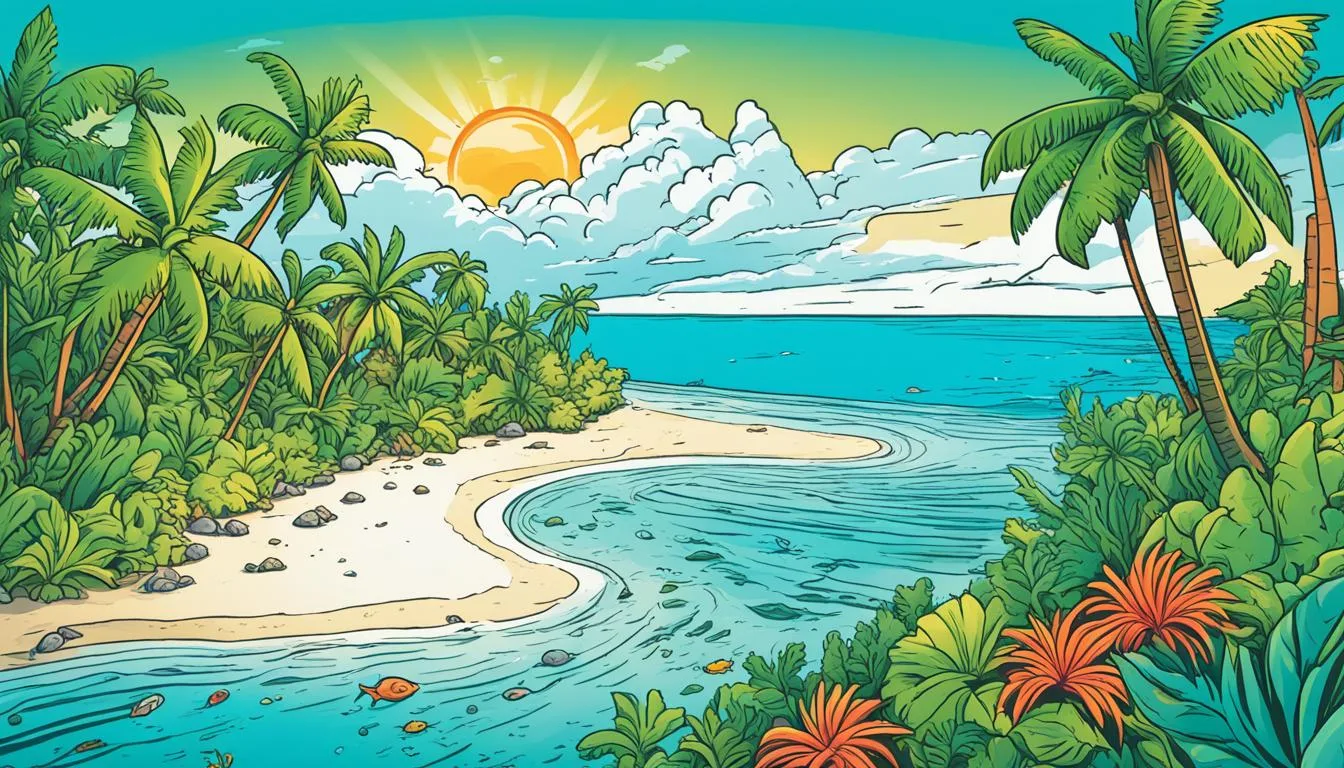Imagine a world where azure waters kiss endless horizons, where the culture thrums with the heartbeat of the Pacific, and where time itself seems to stand still amidst the gentle sway of the palm trees. This is not a mere daydream—it’s the reality awaiting in the scattered coral atolls of Kiribati. As a frontier for the intrepid, this Pacific paradise begs the question: What is the best time to visit Kiribati and immerse oneself fully in its untouched beauty?
Navigating the complexities of Pacific island travel requires insider knowledge, and pinpointing the ideal months to travel to Kiribati is crucial for curating a memorable experience. With its vibrant natural spectacles and rich cultural tapestry, crafting your journey with a reliable Kiribati vacation planner is essential to capture the essence of this island nation’s alluring charm. Whether you seek serenity or adventure, understanding the nuances of Kiribati’s climate will unlock the secrets to scheduling your perfect escape.
Key Takeaways
- Identifying the ideal travel window for optimal weather and experiences.
- Engaging with Kiribati’s culture and natural wonders during the prime months.
- Planning ahead with a tailored vacation planner for a seamless adventure.
- Embracing Pacific island travel with a knowledgeable approach to Kiribati’s seasons.
- Navigating transport options and cultural experiences for a genuine immersion.
An Introduction to Kiribati’s Natural Splendor
The Republic of Kiribati, emerging from the azure depths of the Pacific, represents an untouched nirvana, where the natural beauty in Kiribati converges with a profound cultural heritage. An odyssey to this part of the world is not merely a vacation; it’s an exploration into some of the planet’s most secluded and breath-taking environments.
Exploring the Remote Beauty of the Gilbert, Line and Phoenix Islands
Enveloped by the vast Pacific Ocean, the Gilbert, Line, and Phoenix Islands archipelagos offer an array of stunning seascapes and vibrant marine life. From the pristine lagoons to atolls vibrant with life above and below the ocean’s surface, these islands epitomize the paradisiacal qualities for which the Pacific island climate is celebrated. The diversity extends from the mangrove-lined shores of Abaiang to the famous atoll of Kiritimati, hosting some of the world’s richest coral reefs.
Understanding Kiribati’s Climate: A Tropical Paradise
When it comes to weather, Kiribati stands as a beacon of tropical stability. The islands, basking under the consistent glow of the equatorial sun, boast temperatures oscillating mildly between 27°C and 28°C. Unlike many world regions prone to seasonal extremes, Kiribati’s climate retains a comforting predictability, although the islands have their own rhythm, dancing to the tune of El Niño and La Niña, with the wet season sometimes inviting the dramatic flourish of tropical storms.
The Cultural Tapestry and Resilient Spirit of Kiribati’s People
The soul of Kiribati is woven tightly with the threads of its traditions and cultural heritage. The Islanders’ lives, rich with distinct dances, nocturnes of communal storytelling, and the vibrant celebrations of National Youth Day and Human Rights and Peace Day, are an integral part of the Kiribati cultural experiences. This cultural mosaic not only portrays the past but also reflects the resilient spirit that animates the archipelago amidst the ever-present challenge of climate change.
Delving into the Best Time to Visit Kiribati
For travelers who yearn to experience the quintessential Pacific island beauty, pinpointing the ideal months to travel Kiribati is key. Spanning from November to April, Kiribati’s dry season invites you with open arms, offering an opportunity to engage with the ocean’s tranquility and clarity. These months are a haven for adventurers eager to dive into aquatic activities amidst the soothing embrace of calmer seas.
During this period, the diminished risk of rainfall paves the way for uninterrupted exploration. In contrast, the wet season may present challenges with its unpredictable weather. Thus, adhering to these Kiribati travel tips ensures a seamless and delightful holiday. Here’s a detailed breakdown of what to expect during these optimal travel months:
| Month | Climate | Aquatic Activities | Cultural Events |
|---|---|---|---|
| November | Warm, beginning of dry season | Excellent for diving and snorkeling | Start of festive season celebrations |
| December | Mildly hot with minimal rainfall | Perfect for fishing and sea kayaking | Christmas and New Year’s festivities |
| January | Comfortably warm with clear skies | Ideal conditions for sailboarding | New Year’s traditional events |
| February | Continued warm, clear weather | Great visibility for underwater photography | Local island fairs |
| March | Starts with dry climate gradually transitioning | Safe for swimming and beach activities | Independence Day preparations begin |
| April | End of the dry season with occasional showers | Last chance for seasonal diving tours | Independence Day celebrations |
Embracing Kiribati during these prime months lets you witness a kaleidoscope of festivities, cultural vibrancy, and the splendor of nature’s playground. Whether your calling is the deep blue sea or the cultural immersion in local festivities, planning your trip in accordance with the ideal months to travel Kiribati will undeniably enhance your Pacific island adventure.
Weather Patterns: Navigating Kiribati’s Seasons
Understanding the weather in Kiribati is essential for planning your trip during the ideal tourist season. Due to its unique position in the Pacific, the nation showcases climate trends that affect not only the livelihood of its residents but also the experiences of its visitors. Learning about these patterns can help you pick the best time for outdoor activities and exploration.

Rainfall and Temperature Trends Across Kiribati
Though Kiribati’s climate is consistently tropical, there are significant variations in rainfall and temperature. The islands experience annual rainfall ranging from 1,000 to 3,000 mm. Heavier rains are more commonplace from March to May, while the rest of the year generally stays drier, ideal for travelers looking to bask in the Pacific sun.
Temperature stability is a feature of the region, with averages pleasantly hovering between 79°F to 82°F (26°C to 28°C) throughout the year. This consistency makes planning your trip smoother, with the weather in Kiribati rarely straying into the extremes that could disrupt travel plans.
El Niño and La Niña: How They Affect Kiribati’s Weather
The climate trends in the Pacific are greatly influenced by larger ocean-atmospheric phenomena like El Niño and La Niña. El Niño periods typically bring about increased rainfall, which could impact travel plans with more frequent wet conditions. Conversely, La Niña can lead to droughts, emphasizing the importance of packing for diverse weather conditions.
Travelers interested in discovering the full splendor of Kiribati’s natural beauty should consider planning their visit between May and December. During this tourist season, Kiribati blooms under the Pacific sun, providing optimal conditions for enjoying the archipelago’s outdoor charms.
Travel Tips: Preparing for Your Kiribati Adventure
To embark on a memorable Kiribati vacation, certain practicalities must be taken into account. Remember, an unforgettable Pacific island travel experience requires more than just booking a flight and packing a bag. Here are key Kiribati travel tips to ensure your journey to this idyllic destination is as carefree as the tropical breezes you’ll soon be enjoying.
Due to the remoteness of Kiribati, flights are not as frequent as other destinations, urging travelers to plan well in advance. Weather can range from sunny skies to sudden squalls, so packing versatile clothing to accommodate changeable conditions is wise. The currency here is the Australian dollar, and with a preference for cash transactions, it’s prudent to have a sufficient amount on hand.
Immersing yourself in the local culture not only enriches your travels but also fosters respect with the residents who call these islands home. Engage with the community, partake in village life, and relish the opportunity to see the world from a different perspective. However, navigating new areas means health precautions are paramount; stay informed on vaccinations and necessary preventative measures against tropical diseases like yellow fever and Zika.
The costs associated with a trip vary significantly, encompassing transportation, food, accommodation, and activities such as snorkeling and diving. A well-informed Kiribati vacation planner will account for these varied expenses. Below is a comprehensive table to help you anticipate the budget for your trip:
| Expense Category | Average Cost | Tips |
|---|---|---|
| Airfare | $1,200 – $2,000 | Book in advance to secure the best deals. |
| Accommodation | $50 – $150 per night | Options range from guesthouses to resorts. |
| Transportation | $20 – $100 per day | Rental cars, taxis, and bikes are available. |
| Food | $30 – $60 per day | Enjoy local cuisine at markets and eateries. |
| Activities | $50 – $200 | Diving, fishing, and tours are popular choices. |
| Health Precautions | $100 – $300 | Consult with a travel clinic for necessary vaccines. |
Discovering Kiribati goes beyond typical tourist activities. It’s an invitation to step into a world that runs at an entirely different pace and to appreciate the serene splendor of the Pacific. Traveling here invites you to adapt, learn, and be transformed, embracing the tranquil allure of the islands and the warmth of their inhabitants.
Unveiling Kiribati’s Top Attractions
When it comes to Pacific island travel, Kiribati stands out with its wealth of activities and experiences, attracting travelers eager to discover top attractions in Kiribati and delve into the depth of Kiribati cultural experiences. Let’s explore what makes these islands a unique playground for adventurers and culture enthusiasts alike.
Experiencing World-Class Fishing and Diving in the Pacific
The pristine waters surrounding Kiribati’s islands are a haven for fishing and diving aficionados. The allure of hooking a giant trevally or wrestling with the powerful bonefish draws anglers from around the world. Divers immerse themselves in the underwater sanctuaries brimming with vibrant coral and bustling marine life. Kiritimati Island, in particular, offers some of the most spectacular sites to witness the rich biodiversity of the Pacific Ocean.

Festivals and National Holidays: A Glimpse into Kiribati’s Celebrations
Cultural richness in Kiribati comes to life during its vibrant festivals and national holidays. These events are not just entertaining; they offer an invaluable window into the soul of the I-Kiribati people. Traditional dance, music, and attire feature prominently during these celebrations, perfectly illustrating the islands’ customs and the community’s strong bonds.
Hidden Gems: Off-the-Beaten-Path Excursions in Kiribati
For those yearning to explore beyond the main tourist spots, Kiribati presents a multitude of off-the-beaten-path excursions. These hidden gems afford travelers the opportunity to engage in bird watching, delve into historical war tours, and visit secluded beaches where the footprints in the sand are likely their own. Village tours are especially enlightening for anyone looking to experience the true essence of Kiribati life—interacting with locals, learning the art of weaving, or taking part in coconut husking.
A Guide to Kiribati’s Peak, Shoulder, and Off-Peak Seasons
When planning a trip to the idyllic atolls of Kiribati, understanding the seasonal variations is essential for crafting the perfect itinerary. Whether you seek the sun-soaked bliss of peak season or the tranquil allure of off-peak travel in the Pacific, each period offers its unique charm and a diverse range of experiences.

Pros and Cons of Traveling During Different Times of the Year
Opting for a vacation during the peak season in Kiribati, typically spanning from November to April, means you’ll enjoy the archipelago’s best weather, perfect for beach escapes and water activities. Yet, it’s also when the islands buzz with the most tourists. Conversely, shoulder and off-peak seasons promise lesser crowds and potentially reduced costs but come with a higher chance of rainfall and typhoons, which could impact outdoor exploration.
What to Expect During the Dry Maritime and Wet Seasons
The dry maritime season ushers in days filled with sunshine, calm seas, and ideal conditions for snorkeling and cultural festivities. The wet season, lasting from May to October, reveals a different facet of Kiribati weather seasons, including lush landscapes and a more intimate glance at the islands’ daily life—though outdoor pursuits might be curtailed by the rain.
In crafting your journey to Kiribati, consider these times of the year and what each season can offer, from the vibrant peak tourist moments to the quieter, yet equally enriching off-peak periods.
Kiribati Holiday Recommendations: Crafting Your Ideal Itinerary
Embarking on a journey to Kiribati encapsulates the essence of true Pacific island travel planning, promising an unforgettable array of experiences. The key to a successful adventure lies in timing and a deep dive into the rich tapestry of culture and nature that Kiribati offers.

If you’re seeking Kiribati holiday recommendations, consider the ideal months to travel Kiribati during the dry season, typically spanning from November to April. This period serves up the perfect concoction of weather conditions for outdoor activities like diving in the crystalline waters or reeling in a giant trevally during an exhilarating fishing expedition.
To aid in your travel planning, below is a table highlighting some of the best activities and cultural events to include in your itinerary to make the most of your trip to this magical Pacific nation.
| Activity | Description | Best Time | Cultural Significance |
|---|---|---|---|
| Snorkeling / Diving | Explore pristine coral reefs and rich marine life. | November – April | Connect with the ocean, integral to Kiribati life. |
| Fishing Expeditions | Experience some of the world’s best game fishing. | Year-round with peak season during dry months | A traditional livelihood reflecting local expertise. |
| Cultural Festivals | Engage with vibrant local celebrations and traditions. | Varies (plan according to event calendar) | Deep dive into the rich cultural heritage of Kiribati. |
| Island Hopping | Discover the uniqueness of each island group. | Dry season for optimal travel conditions | Experience the diversity of life across atolls. |
As you craft your itinerary, remember to build in time to engage with the inviting community life. Attending a local dance performance, tasting traditional dishes, or simply sharing stories with the locals can be the highlight of your Pacific island travel planning. With each island offering its own unique adventure, your visit to Kiribati can be as diverse and enriching as the islands themselves.
Whether you are snorkeling in the clear waters of the Gilbert Islands, angling for the catch of a lifetime on Christmas Island, or soaking in the history of the Phoenix Islands Protected Area, your trip to Kiribati is sure to captivate your heart and soul. Start planning your getaway today, and look forwards to sunny days filled with culture, nature, and serenity in one of the Pacific’s precious gems.
Conclusion
In summing up this Pacific island journey, Kiribati stands out not just on the map—as scattered jewels across the vast blue canvas of the ocean—but in the hearts of those who visit. To visit Kiribati is to step into a world where the warmth of its people enhances the endless summer one experiences here. This destination, though requiring some effort to reach, offers pure, unfiltered Pacific island beauty coupled with a pulsating, resilient culture that leaves a lasting impression on its guests.
Embracing the Singular Charm of Kiribati’s Islands
The enchantment of Kiribati lies in its bounty of natural treasures and the genuine encounters with its culture. These islands welcome adventurers with open arms, providing serene, picturesque landscapes seldom seen elsewhere. From turquoise waters to sprawling reefs and friendly villages, the charm of Kiribati’s islands is indeed singular, befitting those who seek connection with nature and culture.
Why Kiribati Should Be Your Next Pacific Island Destination
When considering your next getaway, look no further than this serene archipelago. Between the breathtaking lagoons and vibrant cultural experiences, Kiribati is an ideal choice for discerning travelers. With this Kiribati vacation planner, you’re well-equipped to craft an unforgettable itinerary that will immerse you in the many splendors this country has to offer. Embrace the opportunity for peaceful retreat and pure adventure that awaits in Kiribati, where the rest of the world feels miles away.
FAQ
What is the best time to visit Kiribati?
The ideal months to travel to Kiribati are during the dry season, from November to April, featuring less rainfall and ideal conditions for water sports and exploring the natural beauty of the islands.
What can be expected from Kiribati’s climate year-round?
Kiribati enjoys a tropical climate with warm temperatures averaging between 27°C and 28°C throughout the year. Relatively high humidity and a dry maritime climate prevail, with the wet season from May to October presenting a higher chance of tropical storms.
How does Kiribati’s culture enhance the travel experience?
The country’s rich cultural experiences are evident in its numerous local festivals, traditional practices, and community bonds. Participating in these cultural tapestries provides travelers with an authentic glimpse into the resilient spirit of Kiribati’s people.
Are there certain weather patterns to be aware of when planning a trip to Kiribati?
Yes, be mindful of the El Niño and La Niña effects, which can significantly affect Kiribati’s weather, causing variations in rainfall and potentially triggering droughts or heavier than usual rains.
What are some essential travel tips when visiting Kiribati?
Plan your trip well in advance due to limited flight options, pack for unpredictable weather, carry cash in Australian dollars for transactions, get necessary vaccinations, and immerse yourself in local traditions for an authentic experience.
What are the top attractions in Kiribati?
Kiribati is famed for its world-class fishing, diving, and pristine environmental hubs like Kiritimati Island. Festivals and holidays offer cultural insights, while off-the-beaten-path excursions provide opportunities for bird watching and war history tours.
When is Kiribati’s peak tourist season, and what does it entail?
The peak tourist season in Kiribati aligns with its dry season, from November to April, featuring the best beach weather. It’s also the most popular time for visitors, so expect more crowd in tourist spots.
What should one anticipate during the wet season in Kiribati?
The wet season, from May to October, tends to be less ideal for outdoor activities due to increased rainfall and the risk of tropical storms, but it also offers lush scenery and the chance to experience Kiribati’s nature in a different light.
What are some recommendations for creating an ideal Kiribati holiday itinerary?
To plan the perfect Kiribati holiday, align your travel with the dry season, partake in the islands’ top water activities, dive into the local culture through festivals, and explore the hidden gems across the Gilbert, Line, and Phoenix archipelagos.
Why should Kiribati be on my travel list for Pacific island destinations?
Kiribati is an enchanting destination with its unparalleled natural beauty, compelling culture, and warm hospitality. It’s ideal for travelers seeking serenity, adventure, and a chance to engage with authentic island culture away from mass tourism.






